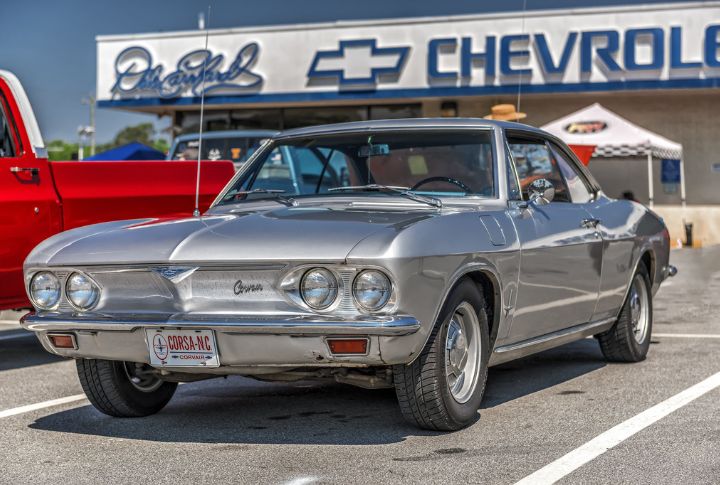
15 Classic Cars that Featured Unique Designs

When it comes to classic cars, design is everything. Some cars dared to defy the norms, sporting designs that were as unique as they were iconic. Let’s take a ride through 15 classic cars that pushed the boundaries of design and left a lasting mark on automotive history.
AMC Pacer

The AMC Pacer, released in 1975, has a unique “jellybean” design and expansive windows. This car featured a compact body with a spacious interior and was powered by a 3.8L or 4.2L inline-six engine. Its distinctive look and focus on safety made it stand out.
Citroën 2CV

With a carefully rounded body, corrugated steel panels, and an incredibly soft suspension, the Citroën 2CV offers a minimalist design and a smooth ride. A simple air-cooled 375cc engine powers the car, offering sufficient power and reliability. The vehicle was designed to be affordable and practical.
DeLorean DMC-12

A stainless steel body and gullwing doors set the DeLorean DMC-12 apart from its contemporaries. Giorgetto Giugiaro crafted its futuristic design, which combined sleek aesthetics and a rear-engine layout. Despite moderate performance, its unique look and role in Back to the Future solidified its legendary status.
Volkswagen Type 181 “Thing”

Known as a boxy and military-inspired vehicle, the Volkswagen Type 181 “Thing” captured the market with its simplicity and versatility. It featured a four-wheel independent suspension and removable doors. Its amphibious capabilities bridged the gap between civilian and military use in the 1970s.
Subaru Brat

The Subaru Brat debuted as a compact pickup with rear-facing jump seats. Designed to avoid the “chicken tax,” it featured a four-wheel drive and a car-like unibody design. This quirky mix of utility vehicle elements and rugged off-road capability made it stand out in its era.
Ford Pinto

After Ford Pinto’s 1971 debut, it became notable for its compact, economical design aimed at affordability and efficiency. Its rear-wheel-drive layout and tiny 1.6 to 2.8-liter engines contributed to its nimble handling. While it was initially well received, the unorthodox fuel tank placement led to safety concerns.
Trabant 601

The Trabant 601 fascinated the public with its unique Duroplast body. This durable and cheap plastic composite was used instead of traditional metal. A 600cc two-stroke engine with just 26 horsepower provided modest performance, while its rear-wheel drive made it a distinctive vehicle of its era.
Fiat Multipla

Distinctive, eye-catching design and innovative features defined Fiat Multipla’s entry into the automobile market in 1998. The Fiat combined practicality with an unconventional aesthetic. Featuring a six-seat layout with three rows of seating, it offered a wide body and a prominent front end with integrated headlights.
Chevrolet Corvair

One remarkable feature of the Chevrolet Corvair was its rear-mounted, air-cooled engine, which was unusual then. A unique independent rear suspension improved handling and ride comfort. Also, its design included a low, sleek profile with a distinctive grille and rounded corners.
Reliant Robin

At its launch in 1973, the Reliant Robin featured a three-wheeled design, which allowed it to be classified as a motorcycle. Such classifications attracted lower tax rates in the UK. It featured a 0.85-liter, 4-cylinder engine, delivering moderate performance with a speed ranging from 70 to 85 mph.
Yugo GV

Several factors made the Yugo GV an economical and practical choice for budget-conscious buyers of its time. They include its compact design, miniature 1.1-liter four-cylinder engine producing 55 horsepower, a 4-speed manual transmission, a simple, boxy shape, and minimalistic interior.
Nissan S-Cargo

Features such as the rounded body and front grille made the Nissan S-Cargo resemble the Citroën 2CV. Introduced in the late 1980s, the car was a distinctive compact van known for its retro-inspired design. Other features included sliding side doors for practicality and a spacious cargo area.
Renault Dauphine

A rear-engine, rear-wheel-drive layout gave the Dauphine a reputation for compactness. It offered a lightweight design, weighing just 1,540 pounds. Aerodynamic styling, a four-door configuration, and advanced suspension made it a popular, practical, and economical choice in post-war Europe.
Ford Edsel

This vehicle was extraordinary and ahead of its time due to its bold, futuristic design, including the unique “horse-collar” grille. It featured advanced technology like the Teletouch push-button transmission in the steering wheel, a 410-cubic-inch V8 engine delivering up to 345 horsepower, and self-adjusting brakes.
Peel P50

The Peel P50 is the world’s smallest production car. Developed in the 1960s, it features a tiny 49cc engine, delivering 4.2 horsepower. This car weighs 130 lbs and measures 54 by 39 inches and with no reverse gear, the P50 can be manually lifted and maneuvered.


